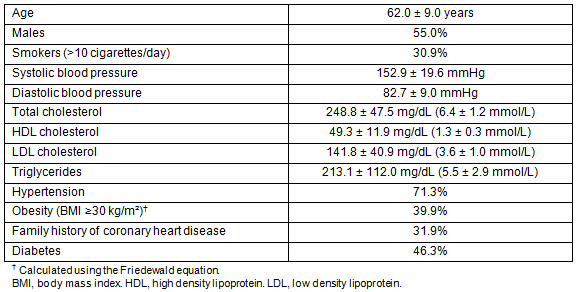The correlation between the plasma level of low density lipoprotein cholesterol (LDL-C) and cardiovascular risk (CVR) has been proven by randomised controlled trials and observational studies1-4 .
The National Cholesterol Education Program Adult Treatment Panel (ATP) III and the new European guidelines on cardiovascular disease prevention have defined target values for LDL-C for cardiovascular disease prevention. The aim is to reach the targets using interventions that vary from lifestyle changes (including increased physical activity and changes in dietary habits) to pharmacological treatment. In general, the guidelines now consider there to be four classes of CVR and recommend that LDL-C levels be maintained below 100 mg/dL (2.6 mmol/L) in high-risk and moderate-risk patients. This goal is substantially lower than previous target levels, of 130 mg/dL (3.3 mmol/L) or below5-9.
In Italy, lipid-lowering therapy is prescribed to only one-third of eligible patients, and many patients do not reach optimal therapeutic targets on treatment10; the use of statins is one-fifth that of Norway, and it is the lowest rate among 13 European countries11. Walley et al11 propose that this low use may either reflect low coronary morbidity or a poor adherence to statins, which is worse in Italy than elsewhere in Europe. In Italy, there is a limitation on the use of statin prescriptions in primary prevention due to nota 13, which establishes the reimbursement paid by the National Health System (NHS) to only those patients with CVR ≥ 20 as rated according to the score system adopted by the Italian Heart Project12. No substantial audit of the quality of lipid management in general practice has yet been carried out in rural southern Italy.
The aim of this audit was to measure the percentage of patients with hypercholesterolaemia in a rural primary care setting in southern Italy, to classify their risk categories and to measure the proportion of those patients who achieved optimal cholesterol levels according to the ATP III guidelines.
Study design
The setting of this audit study was three practices in the rural area of Province of Caserta, Campania, southern Italy. Ten family doctors with approximately 12 000 total patients participated. Data were collected from the electronic lists of hypercholesterolaemic patients of these 10 family doctors (records dating from 1 January 2005 to 31 December 2007).
Selection of study subjects
Every family doctor entered a search key for subjects with a diagnosis of hypercholesterolaemia and/or on hypercholesterolaemic treatment in their own electronic patient records database.
Patients taking statins for less than 2 months and subjects without laboratory test data were excluded from the study, as were those with dementia or other inability to give written informed consent. Inclusion criteria were a diagnosis of hypercholesterolaemia and/or being treated for hypercholesterolaemia for more than 2 months.
Measurements
Variables evaluated were smoking habit (defined as >10 cigarettes/day), hypertension (antihypertensive therapy blood pressure on examination ≥140/90 mmHg), family history of coronary disease, high density lipoprotein cholesterol (HDL-C) <40 mg/dL (<1.03 mmol/L), diabetes mellitus and CVR ≥20. The new European Guidelines on cardiovascular disease prevention in clinical practice and the ATP III 2004 consider there to be four classes of risk7-9, but at the time of this study the Italian regulations for prescribing statins related to the 2002 ATP III guidelines, which considered only three classes of risk.
Subjects were therefore divided into three risk classes: I: personal history of coronary disease, CVR ≥20, diabetes mellitus; II: two risk factors, CVR ≤ 20; III: 0-1 risk factors, CVR ≤20.
The target levels of LDL-C in these subjects were:
- I: 100 mg/dL (2.6 mmol/L); 160 mg/dL (4.1 mmol/L) total cholesterol
- II: 130 mg/dL (3.3 mmol/L); 200 mg/dL (5.2 mmol/L) total cholesterol
- III: 160 mg/dL (4.1 mmol/L); 240 mg/dL (6.2 mmol/L) total cholesterol.
The effectiveness of lipid-lowering therapy was evaluated by comparing the lipid levels of subjects on therapy with the target levels. According to these data, the patients were then classified as:
- on target: LDL-C lower or equal to levels of affiliated class
- poor control: 1-30 mg/dL (0.03-0.78 mmol/L) above the LDL-C target level
- very poor control: ≥31 mg/dL (≥0.8 mmol/L) above the LDL-C target level.
CVR was calculated using the European guidelines (Systematic Coronary Risk Evaluation or SCORE), with reference to the Southern European population, adapted to the Italian population by the Italian Heart Project12-14.
Data analysis
Data were collected in a common database. Continuous variables were reported as the mean values ± standard deviation, and categorical variables were reported as percentages. A statistical analysis was performed using Epi-Info 2008 v3.5 (Centers for Disease Control and Prevention; http://wwwn.cdc.gov/epiinfo)
Ethical issues
The subjects' identities were protected, and no individual subjects could be identified from the data. A subject information sheet with simple straightforward information about the research was given to all the patients and doctors involved, and an informed consent form was signed by the participants.
This study does not involve collection of new data. The approval of the ethical committee was not required as this was neither an interventional nor an observational study on pharmacological treatment. The patients and the doctors involved encountered no harm because this was only an audit of patients with hypercholesterolaemia.
For these type of studies in Italy, a notification is only required by the Ethics Committees of participating centres, and the approval begins 60 days following the date of notification using the silence/consent procedure.
A total of 194 patients were included in the study. The average age was 62.0 ± 9.0 (range 25-80 years), and 55% were male. The basal features of the population are shown in Table 1. The average levels of total cholesterol, triglycerides, HDL-C and LDL-C at baseline and after usual treatment are reported in Table 2. The percentage of subjects at target, with poor control and very poor control of LDL-C in target class I is shown in Table 3.
The CVR calculation for all subjects in primary prevention was performed according to the Systematic Coronary Risk Evaluation score adjusted to the Italian population by the Italian Heart Project12. In Italy, statins are free of charge depending on the Progetto Cuore score. This system is a sort of SCORE project adapted to the Italian population, which tends to give a lower risk score compared to the score for southern European populations. Of the 194 subjects analysed using the Italian risk chart, 58.7% had a CVR ≥20, while 42.3% showed a CVR <20.
Table 1: Blood pressure, lipids and relevant medical history of study subjects

Table 2: Lipidic profile of study subjects

Table 3: Number and percentages of study subjects at target, with poor control and with very
poor control of LDL-C before and after usual therapy with statins (class I of target) (n=114)

Discussion
Main findings
In this first audit of subjects with hypercholesterolaemia in an Italian rural area, the percentages of them at target, with poor control and very poor control in of LDL-C target level class I after 2 months of statin use were 24.6%, 30.7% and 44.7%, respectively. Although guideline recommendations focus more on the control of risk factors to prevent cardiovascular disease8,9, the poor aptitude in achieving these goals may vary based on family doctor or patient knowledge of and behaviour towards Italian economic plans and rules.
At the time of the study, patients with dyslipidaemia were referred to the specialist for their first statin prescription. While it was easy for citizens to reach the hospital, it was not the same for rural patients, so family doctors in the study area usually prescribed statins themselves. Perhaps this contributed to a higher number of patients reaching their target in that area.
This audit was not designed as a study of the efficacy of lipid-lowering treatments in achieving therapeutic targets according to the guidelines.
In Italy, lipid-lowering therapy is prescribed only to one-third of eligible patients, and many subjects do not reach their ideal therapeutic target on treatment10. The motivations behind this attitude are heterogeneous and related to physicians, patients and economic planners15,16. National guidelines and policies could also be major factors in this Italian phenomenon17. Raithatha and Smith18 speculated that people who could benefit from statins are not currently receiving them largely for economic reasons. In Italy, reimbursement for the statin therapy is regulated by the Unique Commission of Drugs (UCD).
Statins can be prescribed free of charge only to patients with CVR ≥20. The rules are very strict, and family doctors can be asked to personally reimburse the healthcare system in cases of 'inappropriate' prescriptions.
Study results in relation to existing literature
The authors did not find any published studies on the quality of lipid management in primary care either in the study area or in the Italian rural area. In this study, 24.6% of the patients were at target, 30.7% had poor control and 44.7% had very poor control in LDL-C target level class I. In a similar study carried out in an urban area of the Lombardy region (northern Italy) in 2003, the percentage of patients in each group in the same class of risk were 14.6%, 30.0% and 62.5%, respectively19.
Failure to meet the target may be due to poor knowledge of the ATP III guidelines19,20; fear by family doctors of greater side effects related to the increased daily dosage19 ; drugs not being free for some patients17,18; poor adherence to treatment caused by patient concerns and awareness18,21. It was not the aim of the study to analyse if any of these factors were associated with poor attainment of target levels. Future studies will be needed to evaluate which factors influence these outcomes. The authors concluded that family doctors had not focused on aggressive lipid lowering in patients at high risk, perhaps because of the limited knowledge of the need for modulating treatment19,20.
Impact on rural healthcare services and policy
At the time of the study, family doctors referred patients with dyslipidaemia to specialists for the first statin drug prescription. Although it was easier for urban patients to go to a specialist and be managed by them, this was more difficult for rural patients. For this reason, family doctors in rural areas often prescribed statins themselves. Further studies have to be performed to assess whether that contributed to the achievement of better LDL-C cholesterol target levels in these rural areas.
According to the Italian regulations, statins are not free when prescribed to patients with a CVR ≤20, while the European guidelines (SCORE) advise treatment with statins in asymptomatic subjects with CVR ≥5, total cholesterol of 5 mmol/L (190 mg/dL) or LDL-C = 3 mmol/L (115 mg/dL) when lifestyle changes are not able to lower the risk13,14.
Strengths and limitations of the study
Only a small number of family doctors took part in the study, and generalisation outside of this setting is to be performed with caution. For blood test analyses, data were obtained from different laboratories, but they all used the same quality-assured standardised instruments. A strength of this study is the high rate of identification of cases with a routinely used electronic medical record, and the unique perspective on a rural practice setting.
Implications for clinical practice, education or research
ATP III guidelines on hypercholesterolaemia treatment are not successfully implemented by family doctors in the study area in rural southern Italy. An attempt by the authors to improve this situation will follow, with individual clinical audits and continuing medical education courses.
This study shows that patients with high cardiovascular risk may be under-treated in rural southern Italy. The reasons behind this phenomenon require further study. Italian healthcare regulation seems to be a barrier to receiving a lipid-lowering drug prescription, and this may influence LDL-C control. Therefore, a change in this strict policy would most likely be beneficial. Advances in patient education and motivation, possibly motivated by family doctors reading these findings, may help increase patient compliance to drugs and the lifestyle modifications.
Acknowledgments
Thanks to the doctors who assisted with data collection: Ciro Pascarella, Alfonso Giovanni Giarrusso, Giovanbattista Viccione, Stefano di Sorbo, Alessandro Correra and Giorgio Massara.
References
1. The Lipid Research Clinics Coronary Primary Prevention Trial results. I. Reduction in incidence of coronary heart disease. JAMA 1984; 251: 351-364.
2. Scandinavian Simvastatin Survival Study Group. Randomised trial of cholesterol lowering in 4444 patients with coronary artery disease: the Scandinavian Simvastatin Survival Study (4S). Lancet 1994; 344: 1383-1389.
3. Heart Protection Study Collaborative Group. MRC/BHF Heart Protection Study of cholesterol lowering with simvastatin in 20536 high-risk individuals: a randomised placebo-controlled trial. Lancet 2002; 360: 7-22.
4. Heart Protection Study Collaborative Group. MRC/BHF Heart Protection Study of cholesterol lowering with simvastatin in 5963 people with diabetes: a randomised placebo controlled trial. Lancet 2003; 361: 2005-2016.
5. Expert Panel on Detection, Evaluation, and Treatment of High Blood Cho1esterol in Adults. Executive summary of the Third Report of the National Cholesterol Education Program (NCEP) Expert Panel on Detection, Evaluation, and Treatment of High Blood Cholesterol in Adults (Adult Treatment Panel III). JAMA 2001; 285: 2486-2497.
6. Detection, Evaluation, and Treatment of High Blood Cholesterol in Adults (Adult Treatment Third Report of the National Cholesterol Education Program (NCEP) Expert Panel on Panel III) Final Report. Circulation 2002; 106: 3143.
7. Implications of Recent Clinical Trials for the National Cholesterol Education Program Adult Treatment Panel III Guidelines. Circulation 2004; 110: 227-239.
8. European guidelines on cardiovascular disease prevention in clinical practice. Fourth Joint Task Force of the European Society of Cardiology and other societies on cardiovascular disease prevention in clinical practice (constituted by representatives of nine societies and by invited experts). European Journal of Cardiovascular Prevention and Rehabilitation 2007; 14(Suppl 2): S1-113.
9. European guidelines on cardiovascular disease prevention in clinical practice (version 2012). The Fifth Joint Task Force of the European Society of Cardiology and Other Societies on Cardiovascular Disease Prevention in Clinical Practice (constituted by representatives of nine societies and by invited experts). European Heart Journal 2012; 33: 1635-1701.
10. Istituto Superiore di Sanità. Drug use and safety: Italian experiences. XV National Workshop. Rome, 11-12 December, 2006.
11. Walley T, Folino-Gallo P, Schwabe U, van Ganse E. Variations and increase in use of statins across Europe: data from administrative databases. BMJ 2004; 328(7436): 385.
12. Gruppo di Ricerca del Progetto CUORE. The Italian Heart Project - longitudinal studies. Italian Heart Journal 2004; 5(Suppl 3): 94S-101S.
13. Thomsen TF. SCORE and SCORECARD: new important tools in cardiovascular disease prevention. Presented at the ESC Congress, 30 August - 3 September 2003, Vienna, Austria. European Guidelines on Cardiovascular Disease Prevention, SCORECARD and EuroAction, Presentation #679.
14. Conroy RM, Pyörälä K, Fitzgerald AP, Sans S, Menotti A, De Backer G et al. on behalf of the SCORE project group. Estimation of ten-year risk of fatal cardiovascular disease in Europe: the SCORE project. Result of a risk estimation study in Europe. European Heart Journal 2003; 24: 987-1003.
15. Pearson TA, Laurora I, Chu H, Kafonek S. The lipid treatment assessment project (L-TAP): a multicenter survey to evaluate the percentages of dyslipidemic patients receiving lipid-lowering therapy and achieving low-density lipoprotein cholesterol goals. Archives of Internal Medicine 2000; 160: 459-467.
16. Harder S, Mohr O, Klepzig H. Lipid-lowering treatment in coronary artery disease: a survey in an ambulatory outpatient clinic. International Journal of Clinical Pharmacology and Therapeutics 2001; 39: 534-538.
17. Davide G. Italy: last position both in use of statins therapy and in the sensitivity of own coronary risk assessment chart. BMJ 2004, 20 February. (Online) 2004. Available: http://www.bmj.com/rapid-response/2011/10/30/italy-last-position-both-use-statins-therapy-and-sensitivity-own-coronary- (Accessed 15 May 2012).
18. Raithatha N, Smith RD. Paying for statins. BMJ 2004, 14 February; 328: 400-402.
19. Tragni E, Alberico L, Bertelli A, Poli A. Raggiungimento degli obiettivi terapeutici per le dislipidemie nella pratica clinica: risultati di un'indagine tra i medici di medicina generale della Lombardia. [In Italian.] Italian Heart Journal 2003; 4(Suppl 7): 47S-57S.
20. Erhardt LR, Hobbs FD. A global survey of physicians' perceptions on cholesterol management: the From The Heart study. International Journal of Clinical Practice 2007; 61: 1078-1085.
21. Cacoub P, Tocque-Le Gousse E, Fabry C, Hermant S, Petzold L. Application in general practice of treatment guidelines for patients with dyslipidaemia: the RESPECT study. Archives of Cardiovascular Diseases 2008; 101: 715-721.





